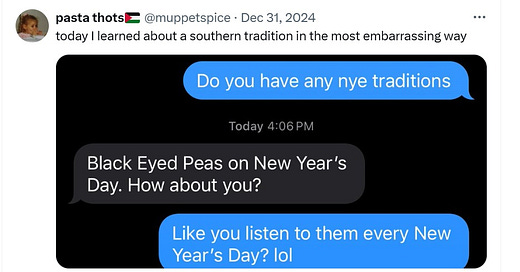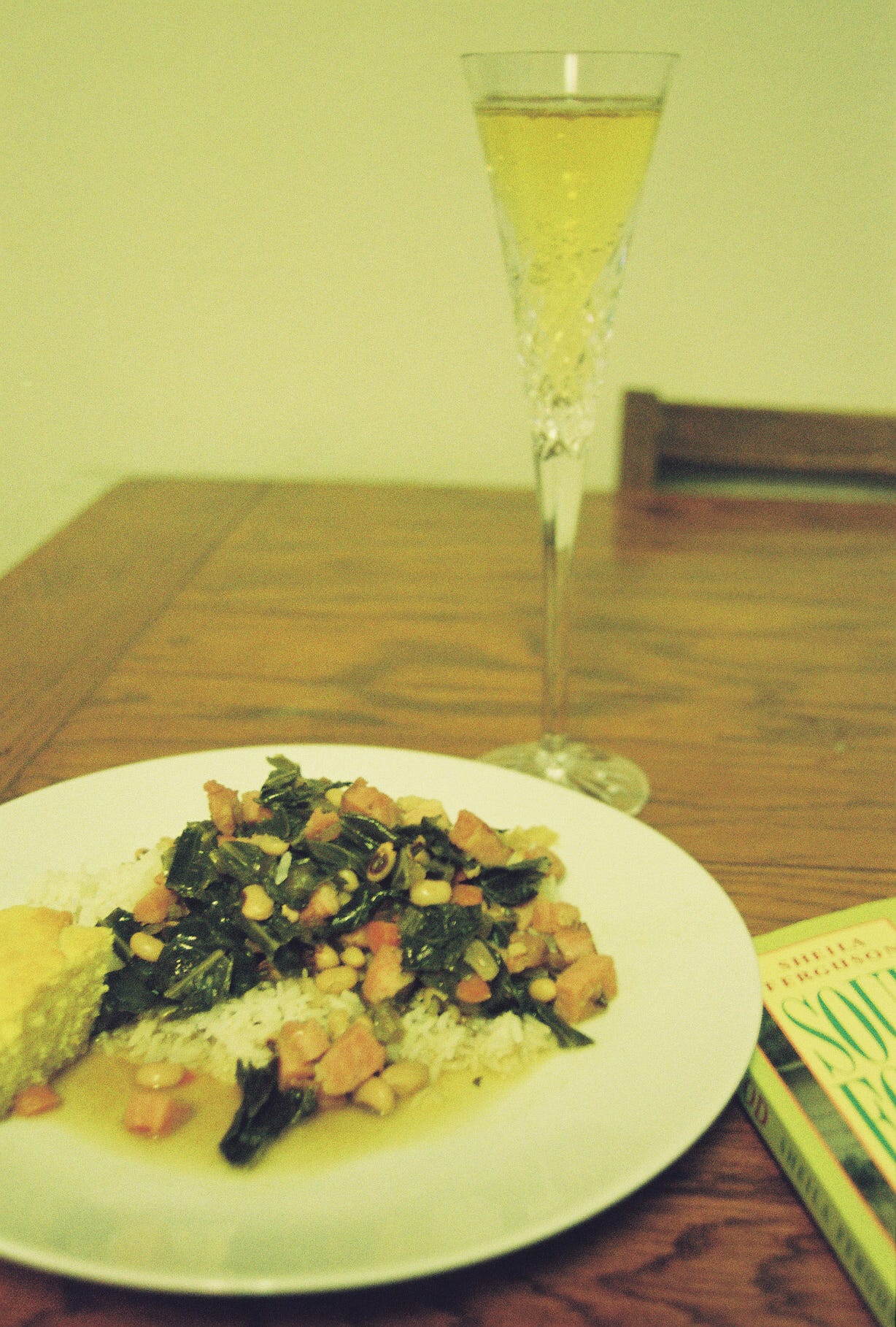Black Eyed Peas and Collards
With a little luck, we can all enjoy this wonderful dish on more than just New Year's day.
Welcome to Tomato House. Here, I explore my love of food, the meals I cook, and how food touches all our lives. I am a home cook, taught by my parents, friends, and many failed meals. I invite you to share my meals and my thoughts, even if you can’t share my table. This is a free publication, but please subscribe to receive the latest essay in your inbox. I’d love to hear your thoughts too, so please leave a comment.
With gratitude.
I have a troublesome Twitter addiction. I scroll for far too long and too frequently. But with gems like this below, how can you not?
I don’t even care if this text happened in real life or was manufactured for Twitter engagement bait. This misunderstanding is a fantastic scene, and it shows how even in our mass media, the monoculture of the 21st century, some regionalism still lives on.
I, too, enjoy black-eye peas on New Year's Day. I learned of the tradition shortly after moving to Texas and liked its simplicity, so I’ve adopted it for the past several years. I also have a soft spot for the Black Eye Peas, the party band of the aughts. I have jammed out to “Let's Get It Started in Here” many a night in my youth, and I think it would be an appropriate and gleeful addition to a New Year’s Day celebration.
Black Eye Peas are supposed to bring luck when eaten on New Years day. The white spot is supposed to be symbolic of a coin. This year I needed all the luck I could get, so I certainly wasn’t gonna skip the tradition, even if I had punted on other holiday celebrations earlier.
Typically, I serve my peas the traditional way with rice and cornbread. But for an extra spot of luck, I got a little rebellious this year and cooked collard greens in the Black Eye Peas. Conventionally, collards are served separately as a side dish, but in addition to my needing luck, I needed fewer pots to wash. The result was a one-pot wonder that, luckily, tasted great.
First, I browned ham cubes, giving them a touch of color and rendering off a little fat. Usually, one uses ham hock, but the store was out of ham hock, so a diced ham steak would have to do. A ham product is essential to this dish as it adds sweetness and saltiness. Pork is a key flavor base in this and much of Southern cuisine.
After browning the ham, I removed it, as it didn’t need to stew for hours since it was already cooked. In the drippings, I added my mirepoix. I added the onions for a few minutes to let them sweat. Then, the carrots and celery. For a punch, I added my homemade garlic chili paste, which I made from garlic and cayenne peppers grown in my garden.
A month or so ago, I harvested the last of my chilis, blitzed them with the last of my garlic harvest, and stored them covered in oil. The batch filled three sweet little jars. One of which I gave as a gift, the other two I hoard for my own use. I pull my homemade condiment out whenever I need a quick hit of flavor and heat. I genuinely believe the short supply chain - from my yard to my kitchen - keeps more flavor in the product than store-bought options. The complexity of the pepper oil is still intact as the peppers didn’t sit in storage for months before being processed, thus drying out their oils. So the chili-garlic goes in the pot with the rest of the vegetables. As I stir, I season the pot gently.
In this instance, when I say “seasoning,” I am only referring to the addition of salt. Seasoning can be a fraught topic in southern/soul food cooking, at least during the age of TikTok. Many people think seasoning, by default, includes garlic and onion powder. Some people don’t think food is properly seasoned without a host of different products such as Lawry’s seasoning salt or Tony’s Creole Seasoning, etc. Those salts and spice mixes can be fantastic. But In my opinion, those are separate ingredients unto themselves. Garlic and garlic powder are two different ingredients that serve different purposes. I love mashed potatoes with a ton of garlic powder. It adds a tang not achieved by fresh garlic. But I did not think adding voluminous dried spice mixes was necessary for this pot of black-eyed peas and collard greens. You’ll see I kept it pretty simple.
I continue to carefully build the layers of flavor in the bottom of the pot, sweating out my aromatics, bringing out the sugars, and evaporating some water, concentrating their flavor. A beautiful fond develops. At this point, I deglaze with homemade chicken broth. I scraped all those wonderful bits of flavor that had adhered themselves to my pot. This is why I didn’t think I needed lots of spices. I was making my flavor at the bottom of the pot. A flavor that I couldn’t find inside a jar.
I used lighter chicken stock. It had some collagen and wiggle but was lighter in color. I hadn’t roasted the bones as heavily, nor boiled the broth as long to make a dark stock. A light roast and a shorter boil lead to a broth with a lighter but still savory flavor. With the recent obsession over “Bone Broth”( which is just another label for stock, but that rant is a different post), it’s easy to glamourize the darkest of stocks that begin to border on demi-glace. However, different types of stock and broth serve different purposes. Lighter broths allow delicate flavors to come through. Light stock doesn’t overpower but rather serves as a canvas to build the rest of your meal.
I added the peas and a couple of bay leaves from my garden. I was cooking this all in an Instant Pot. So, I switched from the sautee setting to the slow cook setting and set the timer for an hour. I know some cooks like to make fun of these countertop cookers, but sometimes they are the right tool for the job. I built my soup base, then walked away for an hour while attending to other things, including having a nice holiday with my family.
During this glorious free time, I prepped the collards. My husband isn’t naturally fond of collards. His complaints are the usual ones. They are too tough and too bitter. I really took his input into account. I was determined to defy his expectations.
I washed the leaves twice, just to be certain. Collards are notorious for holding on to dirt. While I wash my collards, I’m a little rough with them. I pull the center spines but will also wring them out in my hands, crunching the more fibrous parts of the leaf. After they are washed, I double-check each leaf, making sure to remove any remaining tough spines with my knife. Then I rolled them up and sliced them into wide ribbons like a giant chiffonade.
After the peas had an hour’s head start, I added the collards. I think there is a sweet spot in cooking collard greens. Not long enough, and they are still tough and bitter. Too long and they are dead. The soup base I created would also flavor the greens and remove their bitterness. Likewise, the greens were going to add flavor to my soup base, turning it into a pot likka.
Typically, one braises collards in water or broth with bacon. The resulting liquid is beloved by collard greens fans and called pot likka. My guess is that “likka” is an evolution of the word “liquor,” but who knows? At this point the official spelling is “likka”, so who am I to question? I let the pot go for another couple hours. Meanwhile, the whole house, my daughter, husband, two dogs, and I all went to the park to play.
By late afternoon, the gang was starting to feel peckish. Which was perfect as my beans and greens were ready—my first stroke of luck for the year. Having food ready when your family starts to get hungry is never guaranteed, but today, I pulled it off. During the last 20 minutes of cook time, I added back in the pork, and boiled up some rice.
The pot with peas, and collards, and pork was getting very full. The liquid just barely held together all the substantive components. The soup base had converted into more of a sauce just based on proportions. I ended up serving the dish on plates. I poured the peas and collards on top of a bed of rice that soaked up wonderful pot likka. I added a slice of cornbread on the side, just to make it extra southern. We all sat down to dig in.
My husband actually liked the collards. And even my toddler daughter ate up the pot likka infused rice. My second stroke of luck on the year. Just one day into 2025 and I already had two victories. I’ll take it.
The dish had an unexpected lightness, considering it cooked so long. The lighter broth, and not cooking any longer than necessary contributed to this. Dare I say the light touch of a slower cooker that maintains a consistently low temperature ensured my peas didn’t overcook and burst. Each pea held its shape. And the ham, which hadn’t cooked long at all, gave a textural contrast against the soft greens and vegetables. The chili spice served balanced the ham's sweetness and the greens' bitterness.
Southern/Soul food is known for its heavy dishes and long cooking times. And while this was undoubtedly a low-and-slow cooking process, nothing about the meal felt heavy. It honestly felt like a good start to a much-needed rest after a month of indulging in holiday treats. I don’t traffic much on the “healthy” label, but as I ate these beans, rice, and leafy greens, I couldn’t help but feel that this meal was downright healthful and life-giving. The beans and rice make a complete protein. Collards have iron. And a little ham just to round it out and make sure it stick to your bones.
This light, healthy dish felt so different from the stereotypes of southern/soul food. Yes, Southern food has many heavy classics: fried chicken, biscuits and gravy, the heavy use of butter. But the more I learn about this food tradition, the more I realize that those dishes are the exceptions, not the rule.
I hope to explore Southern food more this year. It’s seemingly misunderstood even in its home region. But for now, I just really hope these Black Eye Peas bring me luck beyond the success they gave me at the dinner table. 2025 will bring challenges no matter what, but armed with life-giving dishes like this one and some killer party beats from Fergie-Ferg, I might just make it.





